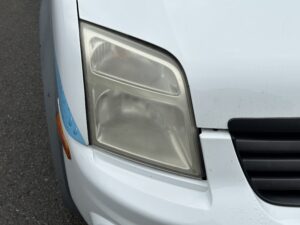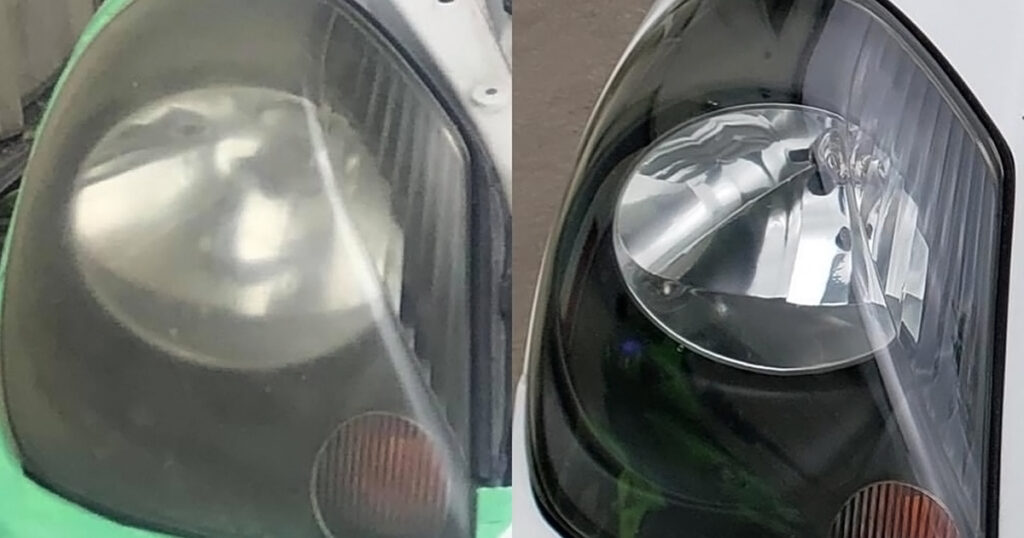Aside from the tires on your car or truck, your headlights are one of your vehicle’s most important safety features. In the past, we’ve talked about the importance of having them aimed properly (https://vzan.org/driving-technology/proper-headlight-aiming-is-crucial-to-road-safety/). This article will discuss maintaining the lenses and repairing faded or yellowed lenses to help you get as much light on the road as possible.
Why Do Headlight Lenses Turn Yellow?
There’s a good chance you’ve noticed a car or truck with headlights that have faded and turned yellow. Why does this happen? Most vehicles have headlight assemblies with clear plastic lenses that are contoured to follow the shape of the vehicle’s body. While making these from glass would be ideal, the cost and complexity of that are prohibitive.
These clear lenses are made from durable polycarbonate using an injection molding process. Once formed, cooled and inspected, a clear protective coating is applied to improve scuff and chip resistance and help prevent yellowing. The coating is similar to the clear coat applied to your vehicle’s painted surfaces. The yellowing and associated fading is oxidation caused by heat and prolonged exposure to UV light from the sun. If you can keep your vehicle in the garage when you aren’t using it, materials will fade less.

Have Your Faded Headlights Repaired
When the lenses turn yellow and fade, the light that reaches the road can be dramatically reduced. According to research by the American Automobile Association, lights with significant fading and yellowing can reduce the effective output by as much as 80%. At even half that, your ability to see objects down the road will be reduced, and your risk of an accident increases.
So, what do you do when your headlights are yellow or faded? The answer is simple: Seek a professional to polish them and apply a new protective coating. The restoration process involves polishing away the top layer of oxidized plastic to reveal clear, healthy plastic. If this fresh plastic is left exposed without a new protective coating, it will turn yellow quickly. The shop restoring your lights must apply a new coating to the lenses.
There’s a myth that paint protection film (PPF) blocks UV. Unfortunately, this isn’t true. If these films blocked UV, the rate at which protected and unprotected paint fades would differ significantly. If the car dealership you purchased your vehicle from applied a strip of PPF across the leading part of the hood, UV-blocking properties would show up as a dramatically different color after a few years. PPF is impressive at preventing chips and scratches and is a worthwhile investment in maintaining the appearance and value of your vehicle.
Headlight Care and Maintenance
Just as you should check the oil in your engine and the washer fluid every month or so, maintaining your lighting system is part of proper vehicle maintenance. Make sure all your lights work. Inspect the lenses (front and rear) for cracks, damage or fading. If your vehicle uses incandescent high beams as daytime running lights, inspect the bulbs for browning and replace them as necessary. Don’t forget to check that the lights are correctly aimed. You can do this by driving up to a wall and observing the beam pattern. The bright spot from your headlights should be lower than the lights themselves.
You can prolong the life of your headlights by keeping them clean. Use a mild car wash soap to remove any bug splatter or dirt. Avoid hard scrubbing, as this will wear away the protective coating. Applying a high-quality wax or sealant to the lenses will make it easier to keep your headlights clean and improve light output when it’s raining by allowing the water to bead and roll off the lenses.
If you need help with headlight repair, restoration or bulb upgrades, contact one of our partner retailers and ask them if this is a service they offer. You can find a list of retailers using our dealer locator tool.


